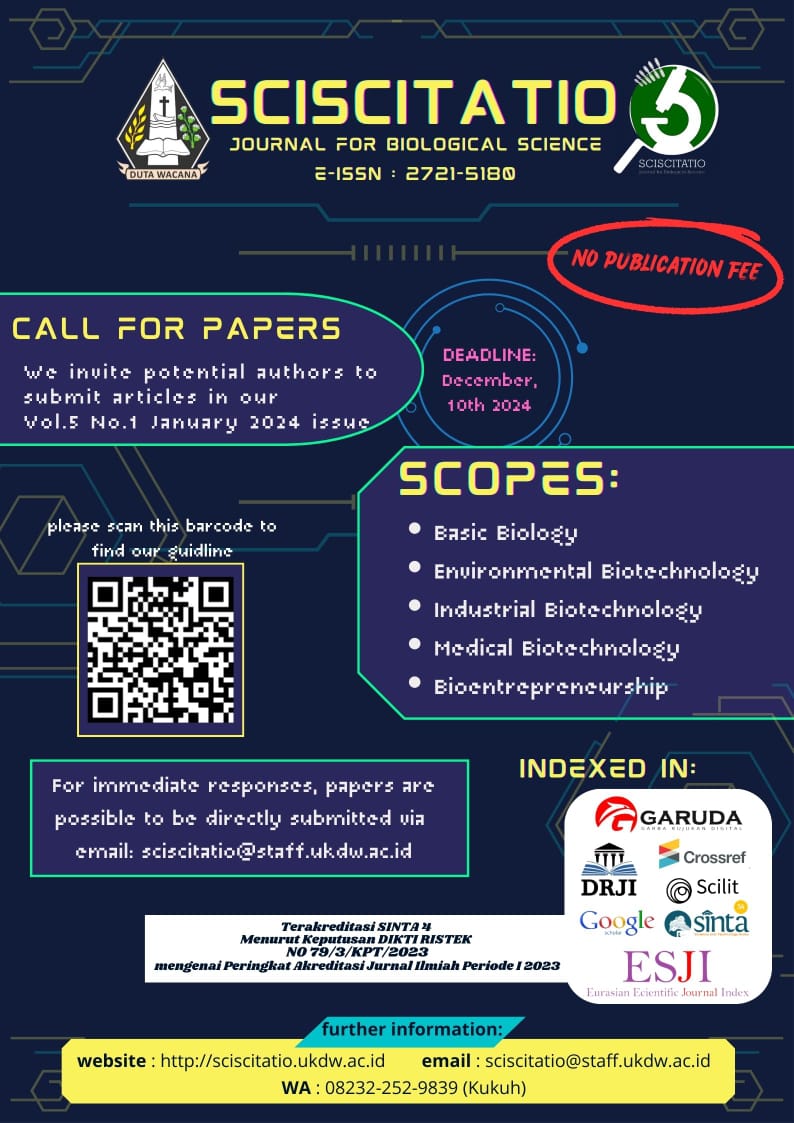Bionomic of Anopheles sp. in Merauke District, Papua
DOI:
https://doi.org/10.21460/sciscitatio.2020.11.20Keywords:
mosquito, Anopheles sp, bionomics, MeraukeAbstract
Malaria is known as an endemic disease that often causes death in Indonesia, especially in Papua. The malaria cases control in Papua has not been carried on based on data studies, therefore bionomic of Anopheles sp is important to be studied. Bionomics data are consisted of breeding places, resting places and feeding habits are from direct observation. Interviews and questionnaires were conducted to gain information about respondent behavior. Descriptive and qualitative data were then analyzed. The breeding places of Anopheles sp. were mostly found in swampy areas. Based on the feeding habit, the feeding activity of Anopheles sp. inside the house has only one biting peak at 23.00-02.00 WIT, while outside the house, biting peaks occurred at 21.00-22.00 WIT and 00.00-01.00 WIT. Resting place data shown that Anopheles sp. mostly found in piles of clothes and shoe racks. Recorded factors that affect mosquitos bionomics are temperature, humidity, salinity, pH, community behavior, and the presence of livestock. Environmental factors (temperature, humidity, salinity, and pH), habitual behavior of host (3M action, the habit of using insect repellent, mosquito repellent, and mosquito nets), the presence of livestock, and the type of bait blood type affect mosquito activity
References
Badan Pusat Statistik. (2019). Jumlah Penduduk Dan Rasio Jenis Kelamin Kabupaten Merauke 2010-2017. https://meraukekab.bps.go.id/ dynamictable/2018/04/26/8/jumlah penduduk-dan-rasio-jenis-kelaminkabupaten-merauke-2010-2017.html
Hoedojo, R & Sungkar, S. (2008). Morfologi, Daur Hidup, dan Perilaku Nyamuk: Parasitologi Kedokteran. Edisi ke 4. Jakarta: Fakultas Kedokteran, Universitas Indonesia.
Kawulur, H., Soesilohadi, H.R.C., Hadisusanto, S., & Trisyono, A. (2015). Perilaku Vektor Malaria Anopheles farauti Laveran (Diptera: Culicidae) di Ekosistem Pantai (Kabupaten Biak Numfor) dan Ekosistem Rawa (Kabupaten Asmat) Provinsi Papua. Bioma, 17(1), pp. 34-40.
Prasadini, M., Dayananda, D., Fernando, S., Harischandra, I., & De Silva, N. (2019). Blood Feeding Preference of Female Aedes aegypti Mosquitoes for Human Blood Group Types and Its Impact on Their Fecundity: Implications for Vector Control. American Journal of Entomology 3(2): 43-48.
Mattimu, A. (1989). Studi Laboratorium Potensi Ikan Mujair (Oreochromis mossambicus Peters) Untuk Pengendalian Hayati Larva Anopheles aconitus D. Tesis Pasca Sarjana. Bogor: IPB.
Sandy, S. (2014). Bionomi Vektor Malaria Kelompok Anopheles punctulatus (Anopheles farautii, Anopheles koliensis, Anopheles punctulatus) di Provinsi Papua. BALABA, 10(1), pp. 47-52.
Windarso, S., Rubaya, A.K., Suwerda, B., & Ganefati S.P. (2008). Studi Bionomik Vektor Malaria di Kecamatan Kalibawang Kulonprogo. JRL 4(2), pp. 111-117. Septiani, L. (2012). Studi Ekologi Tempat Perindukan Vektor Malaria Di Desa Sukamaju Kecamatan Punduh Pedada Kabupaten Pesawaran Propinsi Lampung. Skripsi. Lampung: Unila.
Setyaningrum, E., Murwani, S., Rosa, E., & Andananta, K. (2008). Studi Ekologi Perindukan Nyamuk Vektor Malaria di Desa Way Muli, Kecamatan Lampung Selatan. Prosiding Seminar Hasil Penelitian dan Pengabdian kepada Masyarakat, pp. 292-299.
Shinta & Marjana, P. (2015). Distribusi dan Perilaku Vektor Malaria di Kabupaten Merauke. Buletin Penelitian Kesehatan, 43(4), pp. 219-230.
Soedarmo, S. S. P., Garna, H., Hadinegoro, S.R.S., & Satari, H. I. (2010). Buku Ajar Infeksi dan Pediatri Tropis. Jakarta: IDIAI. Sucipto, C. D. (2011). Vektor Penyakit Tropis. Yogyakarta: Gosyen Publishing.
Sukowati, S & Shinta. (2014). Habitat Perkembangbiakan dan Aktivitas Mengigit Nyamuk Anopheles sundaicus dan Anopheles subpictus di Purworejo, Jawa Tengah. Jurnal Ekologi Kesehatan, 8(1), pp 915-925.
Sukowati, S. (2008). Masalah Keragaman Spesies Vektor Malaria dan Cara Pengendaliannya di Indonesia. Orasi Pengukuhan Profesor Riset Bidang Biologi Lingkungan. Jakarta: Badan Penelitian dan Pengembangan Kesehatan, Departemen Kesehatan.
Susanna, D & Eryando, T. (2011). Faktor Dominan yang Mempengaruhi Kejadian Malaria di Perdesaan. Jurnal Kesehatan Masyarakat Nasional, 4(4), pp. 180-185. Suwito., Hadi, U. K., Sigit, S. H., & Sukowati S. (2010).
Hubungan Iklim, Kepadatan Nyamuk Anopheles dan Kejadian Penyakit Malaria. Jurnal Entomologi Indonesia, 7(1), pp. 42-53.


